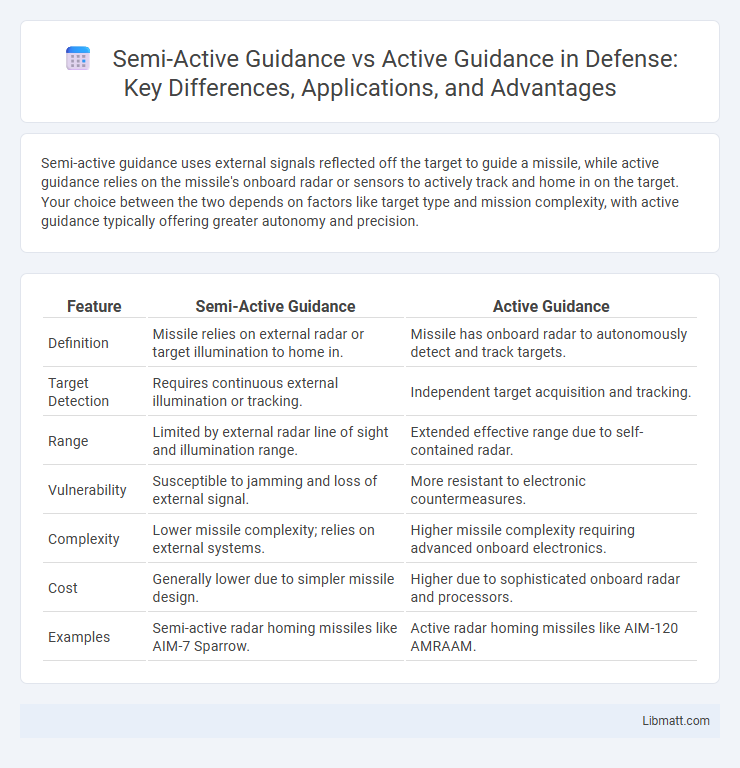Semi-active guidance uses external signals reflected off the target to guide a missile, while active guidance relies on the missile's onboard radar or sensors to actively track and home in on the target. Your choice between the two depends on factors like target type and mission complexity, with active guidance typically offering greater autonomy and precision.
Table of Comparison
| Feature | Semi-Active Guidance | Active Guidance |
|---|---|---|
| Definition | Missile relies on external radar or target illumination to home in. | Missile has onboard radar to autonomously detect and track targets. |
| Target Detection | Requires continuous external illumination or tracking. | Independent target acquisition and tracking. |
| Range | Limited by external radar line of sight and illumination range. | Extended effective range due to self-contained radar. |
| Vulnerability | Susceptible to jamming and loss of external signal. | More resistant to electronic countermeasures. |
| Complexity | Lower missile complexity; relies on external systems. | Higher missile complexity requiring advanced onboard electronics. |
| Cost | Generally lower due to simpler missile design. | Higher due to sophisticated onboard radar and processors. |
| Examples | Semi-active radar homing missiles like AIM-7 Sparrow. | Active radar homing missiles like AIM-120 AMRAAM. |
Introduction to Missile Guidance Systems
Missile guidance systems are categorized primarily into semi-active guidance, which relies on external radar or laser illumination for target tracking, and active guidance, where the missile independently emits signals to detect and home in on targets. Semi-active guidance systems depend on a separate platform to illuminate the target, such as ground stations or aircraft, providing continuous target updates. Active guidance missiles contain onboard radar or infrared seekers, enabling autonomous tracking and higher target engagement flexibility.
Understanding Semi-Active Guidance
Semi-active guidance relies on external illumination, such as radar or laser signals, reflected from the target, enabling the missile to home in using onboard sensors without emitting its own signals. This method enhances your missile's stealth by minimizing electronic emissions compared to active guidance, which requires an onboard radar to continuously emit signals towards the target. Understanding semi-active guidance helps optimize weapon system design by balancing accuracy, cost, and detectability on the battlefield.
Exploring Active Guidance
Active guidance systems use onboard sensors and processors to independently track and adjust the flight path toward a moving target, enhancing precision and adaptability. Unlike semi-active guidance, which relies on external illumination or signals, active guidance provides real-time target data, reducing reliance on external sources and improving your weapon system's effectiveness in dynamic environments. This technology is crucial for modern defense applications requiring rapid response and high accuracy.
Key Differences Between Semi-Active and Active Guidance
Semi-active guidance relies on an external source, such as a radar or laser designator, to illuminate the target, while the missile itself only homes in on the reflected signals. Active guidance systems contain their own onboard radar or sensor to detect and track the target independently throughout the flight. Semi-active guidance typically requires continuous target illumination from a launching platform, limiting flexibility, whereas active guidance offers greater autonomy and operational range.
Technology Components of Each Guidance Method
Semi-active guidance relies on external sensors, such as radar or laser designators, that illuminate the target, which your missile then homes in on using onboard seekers. Active guidance incorporates both target detection and tracking within the missile itself, featuring integrated radar or infrared sensors for autonomous targeting without external input. Key technology components for semi-active systems include ground or airborne illuminators and passive seekers, while active systems depend on built-in transmitter-receiver units and sophisticated onboard signal processors.
Advantages of Semi-Active Guidance
Semi-active guidance offers enhanced target detection accuracy by relying on external illumination sources, reducing onboard sensor complexity and weight. This guidance type increases system reliability and cost-effectiveness since it eliminates the need for active emissions, making your missile less detectable by enemy countermeasures. Its ability to operate effectively in low-signature environments ensures improved mission success rates compared to fully active guidance systems.
Benefits of Active Guidance
Active guidance offers enhanced precision by utilizing onboard sensors and real-time data processing, allowing missiles to independently track and adjust their trajectory toward moving targets. This technology provides greater reliability and effectiveness in complex or cluttered environments where external signals may be jammed or disrupted. Your targeting systems benefit from improved accuracy and adaptability, resulting in higher mission success rates compared to semi-active guidance.
Limitations and Challenges of Both Guidance Types
Semi-active guidance systems rely on external target illumination, which limits their effectiveness in environments with signal interference or countermeasures and requires continuous line-of-sight for accurate tracking. Active guidance systems, while more autonomous due to onboard sensors emitting and receiving signals, face challenges such as higher cost, increased weight, and vulnerability to detection and jamming by enemy forces. Your decision between these guidance types should consider operational constraints like electronic warfare susceptibility and platform integration complexity.
Real-World Applications and Use Cases
Semi-active guidance systems, such as laser-guided bombs and infrared homing missiles, are widely used due to their cost-effectiveness and reliance on external target illumination, making them ideal for scenarios where friendly forces can designate targets. Active guidance systems, employed in advanced radar-guided missiles and autonomous drones, incorporate onboard sensors and computing to independently track and engage targets, providing higher precision and flexibility in complex or jamming-prone environments. Real-world applications of semi-active guidance dominate on battlefields with ground support, while active guidance is preferred in high-threat zones requiring minimal external support and long-range engagement capabilities.
Future Trends in Missile Guidance Technologies
Semi-active guidance relies on external target illumination, requiring constant tracking support, whereas active guidance integrates onboard sensors and radar for autonomous target detection and engagement. Future trends emphasize enhanced AI integration, multi-sensor fusion, and increased autonomy in missile systems to improve accuracy and resistance to electronic countermeasures. Your strategic advantage will grow with missiles featuring adaptive guidance algorithms that dynamically respond to evolving threats in complex environments.
semi-active guidance vs active guidance Infographic

 libmatt.com
libmatt.com